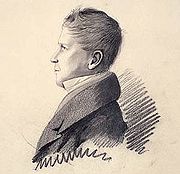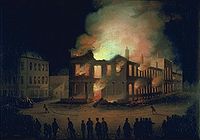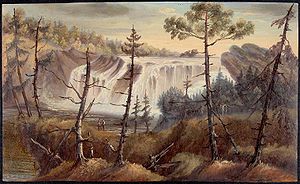
Joseph Légaré
Encyclopedia

Seigneurial system of New France
The seigneurial system of New France was the semi-feudal system of land distribution used in the North American colonies of New France.-Introduction to New France:...
and political figure in Lower Canada
Lower Canada
The Province of Lower Canada was a British colony on the lower Saint Lawrence River and the shores of the Gulf of Saint Lawrence...
.
Early life
The eldest son in a family of six children, Joseph Légaré was born in Quebec CityQuebec City
Quebec , also Québec, Quebec City or Québec City is the capital of the Canadian province of Quebec and is located within the Capitale-Nationale region. It is the second most populous city in Quebec after Montreal, which is about to the southwest...
, the son of a cobbler also called Joseph and Louise Routier, and was educated at the Petit Séminaire de Québec
Petit Séminaire de Québec
Le Petit Séminaire de Québec is a private French-language Roman Catholic secondary school in the Vieux-Québec area of Quebec City which was originally part of the Séminaire de Québec...
. The financial success of his father as a business man was augmented by extra loans he made and properties rented out. The family became relatively wealthy as a result. The young Joseph spent three years of study at the Seminaire de Quebec but he discontinued his studies in July 1811. On 19 May 1812 he was apprenticed as a painter and glazier with Moses Pierce.
Middle Period
On 21 April 1818 Légaré married Geneviève Damien. He owned part of the fief of Saint-François from 1827 to 1841. A self-taught artist, he began painting reproductions of European religious works and later produced his own paintings, receiving a medal from the Société pour l’Encouragement des Sciences et des Arts en Canada in 1828. He was the first landscape artist of French-Canadian origin. In 1833, Légaré opened his own gallery in Quebec City, the first art gallery in Canada; it closed two years later. In 1838, he opened another gallery in partnership with lawyer Thomas Amiot. Légaré served as a member of the municipal council for the city and the board of health; he also served as a justice of the peaceJustice of the Peace
A justice of the peace is a puisne judicial officer elected or appointed by means of a commission to keep the peace. Depending on the jurisdiction, they might dispense summary justice or merely deal with local administrative applications in common law jurisdictions...
. In 1842 he helped found the Saint-Jean-Baptiste Society
Saint-Jean-Baptiste Society
The Saint-Jean-Baptiste Society is an institution in Quebec dedicated to the protection of Quebec francophone interests and to the promotion of Quebec Sovereignism. Its current President is Mario Beaulieu....
at Quebec and gathered signatures for a petition in support of the Ninety-Two Resolutions
Ninety-Two Resolutions
The Ninety-Two Resolutions were drafted by Louis-Joseph Papineau and other members of the Parti patriote of Lower Canada in 1834. The resolutions were a long series of demands for political reforms in the British-governed colony....
. Légaré was an unsuccessful candidate for a seat in the legislative assembly in 1848 and 1850.
The Connoisseur
On the municipal and provincial levels, Légaré's political engagement did not preclude an active role within the cultural life of his time. His activities both as collector and propagandist for art qualify him not merely as a pioneer but as one of the "very first connoisseurs". The "Desjardins Collection" had an enormous influence on his career and he purchased thirty of the works using a loan provided by his father in July 1819. These thirty works formed the nucleus of his collection. The majority of his later acquisitions came through Johan Christopher Reiffenstein and G.D. Balzaretti, two Quebec merchants.
Historical Paintings
Légaré painted a number of works depicting the "customs of North American Indians". However, some of his more memorable works include: First Monastery of the Ursulines at Quebec, Memorials of the Jesuits of New France, The Martyrdom of Brothers Brebeuf and Lalement and The Battle of Sainte-Foy.Later years
The overall achievement of Légaré contrasts with that of his prolific contemporaries Roy-Audy, Antoine PlamondonAntoine Plamondon
Antoine-Sébastien Plamondon was a Canadian artist who painted mainly portraits and religious images in 19th-century Quebec.- Life :Plamondon was born in 1804 at L'Ancienne-Lorette, Quebec, the son of the village grocer...
and Theophile Hamel. Légaré's relative financial freedom allowed him to paint as he pleased without having to worry about saleability. He sold several works to parish churches and religious orders but did not always find a ready market for his works. Many of his landscapes "were all but rejected by his fellow countrymen, as other of his works were, because of his political opinions". Many of his supporters were "as newspapers of the day often emphasized, foreigners". He was named to the Legislative Council of the Province of Canada
Legislative Council of the Province of Canada
The Legislative Council of the Province of Canada was the upper house for the Province of Canada, which consisted of the former provinces of Lower Canada, then known as Canada East and later the province of Quebec, and Upper Canada, then known as Canada West and later the province of Ontario...
in February 1855 and died in office in Quebec City at the age of 60.

External links
- Artist's gallery at the National Gallery of CanadaNational Gallery of CanadaThe National Gallery of Canada , located in the capital city Ottawa, Ontario, is one of Canada's premier art galleries.The Gallery is now housed in a glass and granite building on Sussex Drive with a notable view of the Canadian Parliament buildings on Parliament Hill. The acclaimed structure was...
- "The Burning of the Parliament Building in Montreal", painting, oil on wood, about 1849, at the McCord MuseumMcCord MuseumThe McCord Museum is a public research and teaching museum dedicated to the preservation, study, diffusion, and appreciation of Canadian history...

